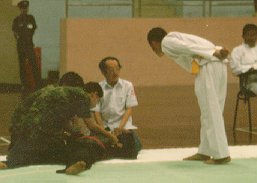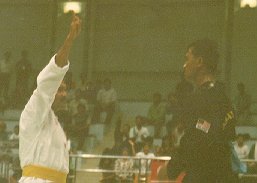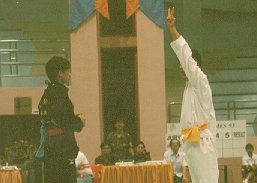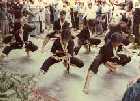



|
Above is a plan of the silat fighting ring, also known as the 'gelanggang'. In actual fact, 'gelanggang' means training area or ground. It does not necessarily look like the one above. But for a silat fighting ring, this is how it looks like. The whole green square is 9m by 9m. But fighting is allowed only in the large circle, measuring 7m in diameter. The fighters square off at a distance greater than or equal to 2m, indicated by the small circle.
|

|
Basic Commands The wasit (referee) will issue the command 'Sedia', meaning 'ready'. Then, he will shout 'Mulai', meaning 'begin'. Immediately the 'gong' will be struck. When the wasit wants to stop the fight, he will shout 'Berhenti', meaning 'stop'. Every time the fighters step out of the ring, the wasit will stop the fight and bring the fighters back to the center. If a fighter repeatedly steps outside the ring, especially if he's stepping backwards, the wasit may issue him a penalty point. If he continues to do that he may be given 2 penalty points. If after that he still continues to step out of the ring, the wasit may even decide to end the fight and proclaim his opponent the winner. There are three rounds of fighting; 2 minutes for every round, with 1 minute rest between each round. Everytime the fight stops for the one-minute break, the wasit (referee) will go to the neutral corner(yellow) farthest from the Doctor's bench(blue). The time-keeper(black) will signal the end of each round with a 'gong'. After one minute, the time-keeper will signal the wasit to start the next round using a yellow flag. Once the wasit shouted 'Mulai!'(meaning 'begin'), the gong will be sounded. Before the fight and during the one-minute rest, the fighters will return to their respective corner, either red or blue. If for some reasons the wasit have to temporarily stop the fight for a long time, either one or both fighters will be signalled to stay inside the neutral corners. As the competition continues, the 3 jurors (cyan) will record the points obtained by the two fighters. The wasit will limit the number of attacks and counter-attacks to 4. This will make it easier for the jurors to give points. After the 4 strikes, if the fighters are still attacking, the wasit will stop the fight and signal the fighters to come back to the ring center to resume another engagement. All through the fight there will be some senior masters sitting in the "Council of Silat Masters" or "Dewan Pendekar"(brown). Their job is to settle any dispute that may arise after the winner is proclaimed. This is only so if the organizing committee(magenta) cannot settle the dispute to the satisfaction of both parties.
Target Area
According to silat ruling, a takedown is when the opponent kicks or punches, the exponent grabs any parts of the limbs (usually the kicking leg), and cause the opponent to fall. If the opponent falls without the exponent losing his balance and falling on top of him, he will get 3 points. If the opponent pulls him down during the technique, the exponent may roll forward, thus avoiding falling on top of his opponent.He will still get the 3 points.
If a fighter can apply punches, kicks, and takedowns in one round, the jurors will add another 1+2+3=6 bonus points to his score for that round. This rule is to encourage the fighters to have more variety in techniques. There is another way to obtain points, that is by applying locking techniques, equivalent to 5 points. But so far in the history of silat competition no fighter has ever managed to use any silat locks during sparring. HHMMMMM.......
Anyway, you should check out the page about takedowns(when it's ready) and understand why experts in takedowns are usually the champions in any silat competition. |
 An example of an advance takedown technique in silat wiralaga. |
 The wasit is indicating that the guy on the left (wearing red sash) is awarded 3 points. |
|
Some words about leg kicks According to the abovementioned rule, leg kicks are technically legal in silat fighting. There is, however, a story about this rule; In 1992, there was an international competition which I participated. Fighters from Thailand are known to have help in training from Muay Thai fighters. Thus, they are vicious in leg attacks. There is this one Thai fighter who had the habit of kicking the legs so hard that his opponent simply cannot stand just after one kick! That was his strategy; kick the legs so hard in the first round, and attack the upper body later to gain more points. Writing this it doesn't sound so bad. But anybody that was there can tell you the scene was quite terrifying. My chief instructor, who happened to be there, remarked that the Thai fighter is too sadistic, and cautioned me , since it is only a 'competition', not to attack until it endangers other people's well-being. Anyone, after fighting that guy, was in such pain that he can hardly walk, regardless of whether he won the fight or not. Anyway, in 1993, the president of PERSILAT, the governing body for the silat international community, made a ruling that a wasit can warn any fighter who kicks the opponent's legs repeatedly, or if the kick was too hard, and to give penalty points if necessary. A fighter that kicks the legs of his opponent until he couldn't stand is liable to be disqualified. But still, leg kicks are allowed, and every silat fighter must be prepared to take a hit on the legs. This is especially so since, although they say strong kicks to the legs are not allowed, THEY NEVER ACTUALLY DEFINE HOW STRONG A KICK HAVE TO BE TO BE CONSIDERED ILLEGAL! That definition is left to the discretion of the wasit at the time of competition. If the wasit is firm, impartial and can control the fight, then it's okay. But unfortunately some wasit are neither firm nor impartial, giving penalty points to one fighter but not to the other fighter even if the same transgression is committed. This is one of the reasons why some fights are so controversial. The fault usually lies with the wasit. He needs to be firm, and yet impartial, and not to be swayed or intimidated by spectators, fighters, sons, daughters, husbands, wives, or anyone else for that matter.
|

 1 penalty point! The jurors will each deduct 1 point. |
 2 penalty points! The jurors will each deduct 2 points. |

|
Above is a picture of a silat exponent well-equipped to take on the challenge of silat Wiralaga. Actually, he's too well-dressed; the wrist bands are practically useless (though it does make him look fierce). Elbow guards are not at all needed; those using it are probably those injured during the previous matches.
The knee guard, however, is quite important as it helps protect your knees during kicking or defending. Some fighters do in fact attack the legs, and it is not uncommon to notice their kicks hitting the knee area unintentionally (or so they say). Although it does not provide much protection, some protection is better than no protection at all. The instep guard is another optional item a silat fighter might use. It is a good idea to wear these, as it helps to prevent ankle sprain. In the rough and tumble world of fighting, an ankle sprain can make a difference between winning or losing. But a fighter must choose his instep guard wisely. Some guards are actually so smooth that they make the wearer slip easily during a fight. In silat fighting, if you fall the wasit may award your opponent 3 points! The next protective gear is the body padding. At a glance it looks similar to Tae Kwon Do's body padding, only that it's black. But the major difference is that the silat padding is 200% softer. You can actually fold a silat padding in two, something you cannot do with a TKD padding. If you get a well-aimed kick to your stomach, you might actually go down. The most important item is, of course, the groin guard (no groin no glory, heh! heh!). In most competitions, especially in Singapore, you bring your own groin guard. You wear it inside your uniform. But in one international competition, some fighters wear it outside (ewwiuu!). Not only that, they use groin guards provided by the organizers, which means that someone else had used it a few matches before ( EWWWWWWIIIIIUUUUUU!). Girls have their own guard but I can't imagine what it looks like. All silat fighters must wear black. Although it is allowed to add a few colours, say on the seams of the collar, generally it must be black overall. Each fighter wears either a red or black sash, usually provided by the organizer. His assistants, usually two, wears an orange sash, along with the normal black silat uniforms.
|
|
The Traditional way I heard that in the old days (I'm talking about 15th-16th century here) they conducted silat graduation ceremonies during the dry season after harvesting. In the ceremony, each silat student will take turns going into the gelanggang with a tester and performing the 'bunga' silat. The 'bunga' is actually silat set forms. But unlike the rigid TKD forms, it looks more graceful and dance-like, resembling Tai Chi exercises. Anyway, silat masters from other schools are invited to attend the ceremony and test these students. The test follows a certain procedure:
If one looks at silat competitions today, one realises that there are similarities in what they do today and what they did in the 'old days'. The fighters in turn perform their schools' version of 'bunga'. Then they shake hands before they fight. They stand diagonally to each other before they begin. Of course they have to have a referee (wasit), and the fighters don't take turns standing with the right or left foot forward (free-style fighting). And of course we must wear propective gear. But in the end the competition itself has a distinct 'flavour' than any other martial arts events. There are kicking and punching techniques much like TKD, but the main differences are the takedowns, and the allowance of 4 techniques/counters for every engagement. So far as I know, other than for those inter-style tournaments, no other similar martial arts use takedowns. Because of the '4 techniques' rule, no prolong clinching results. There is one aspect of silat competition fighting that really sets it apart from other martial arts; Let's say you square off. Then you start jumping around like in TKD or boxing. The wasit will stop the fight and warn you to fight like a silat exponent! What he means is that you should square off in the traditional silat manner, and the way you approach your opponent, even if your movement is fast, must show resemblance to the silat 'bunga'. Not to say exactly like the 'bunga' set form, but at least move your hands and feet in the distinctly silat style. You'll have to see it to really understand it. The good part is that it does make silat fights less taxing. Personally, I prefer the silat style to the TKD or boxing style because the latter style makes me waste too much energy 'dancing' around the ring. Furthermore, the silat style gives me a chance to catch my breath before another engagement. And most importantly, you don't tire your legs as much as in TKD or boxing (I was in TKD for 4 years before studying silat, so that's how I know). The bad part is; when you're fighting, you want to concentrate on the opponent and not worry about tradition! As an example; In one world championship there was this guy from England (I think) square off in the traditional silat manner. He moved forward closer and closer to his opponent, similar to the silat 'bunga'. Watching him, I could see that he was taking great care that his movements was graceful and flawless. I guess that's why he never saw that sidekick coming! He ended on the mat, but at least his movements were nice.... When I fight, I usually square off in silat style. When I want to move closer to my opponent slowly, I do what the guy from England did. But when the opponent is within fighting range I don't do 'bunga' anymore! I stood my ground like in TKD minus the jumping. After each engagement, I'd probably move in silat 'bunga' sequence, but I include breathing in and out with the movements. This is so to help me catch my breath faster before another melee.
The Dark Ages There are even stories of silat groups that, after their members were defeated, resorted to black magic to curse the fighter that defeated it's members. The reason why this happens, that there is so much fighting outside the ring, is because in those days there is a lot of hatred between silat schools. Each school seek to show its superiority over other schools. When they can't show it in the ring, they show it in another way. It was important to show superiority because of fear of being taken over by another school (check out the last part about the history of SSGPS, 1948), which did happen a number of times. Because of that there were many instances where fights broke out between students from different schools. That was why, in those times, those participating in silat activities were looked upon suspiciously by both the government and the general public. Fortunately, nowadays the situation is much better. Instructors and masters from different silat groups are now able to sit around the same table without much problems. This is partly because the tradition of challenging one another has been long forgotten, and that most schools saw that the only way their school or any other school is to succeed in modern Singapore is by maintaining a good image before society. Nowadays, silat instructors cooperate to conduct tournaments, refereeing seminars, and more. Enmity is still present between different instructors of different schools, but this is because of conflict between the two individuals, and does not involve their respective schools at all. And even if there is some involvements by their schools, it never comes to the point of physical violence. They'd probably settle it through discussions or meetings, possibly through one of the meetings in PERSISI (Singapore Silat Federation). Anyway, there are some unofficial rules that everyone in the silat community seems to follow.They are:
 A glorious moment for a victorious fighter. Allow me to make some comparisons between TKD and silat. The reason that I make this comparison is not because silat is superior, but because by making a comparison with the commonly known Tae Kwon Do, I hope to help readers get a more accurate picture of silat competition fighting. As you know, you cannot hit your opponent on the head. But in actual fact, you can get hit on the head. Some silat fighters hit their opponents on the head by, instead of striking the opponent's head, executing a silat takedown and aiming his head on the mat. There was one guy from Indonesia that has the habit of throwing his opponent in such a way that his opponent hit the mat head first. His opponent was able to get up, but after that it was clear who the winner will be. Another way to get hit on the head is when the opponent actually punches you square in the face. Of course if after that you cannot fight, the wasit will disqualify your opponent. However, this may not happen, because let's say you duck your head downwards, your opponent punches and land his fist on your lips. The wasit may decide that you purposely lower your head and that you being struck on the head is your own fault! He will then proceed to count 10 seconds (with the help of the time-keeper) until you sober yourself ready to carry on with the fight. If you cannot sober yourself, then the wasit may award the match to your opponent. Some fighters do actually let their opponent punch them on the face, so that they can get an easy victory when they started rolling on the mat pretending to be in agony. Some fighters, when you punch their shoulder (for example), will start pretending to get hit on the face and showing extreme, excrutiating pain. In silat we call this 'Sandiwara', meaning something like 'Soap Opera'. Now if you did dodge, then true enough it is your own fault. But sometimes it is quite clear that the opponent aims for the head, and that the other guy did not dodge downwards (maybe he just looks down), but still the wasit blaims the other guy. We call this 'referee kayu' (wasit like a wooden plank, cannot think properly). Therefore, a silat fighter must be prepared to take some licks on his face. Although there's no way to train your head to receive punches, you can mentally prepare yourself for any eventuality. Incidentally this is the part when boos and curses and f*** y**'s will come from the spectators. Strikes to the groin......... Enough said. In arts like TKD or Karate, when you spar you will wear shin pads. Silat fighting in Singapore disallows such pads. Some sources cited wearing these pads as cowardly. Thus, a silat fighter must somehow train to receive strikes on the shin. This way, he may be more able to withstand the pain associated with attacks or collision on his shin. It is also worth mentioning that the ability to withstand pain on the shin area seems to be proportional to a fighter's morale, so one can see how important this is. Although it is written that fighters can only attack and counter-attack 4 times, some fighters do actually attack even after the wasit yells 'berhenti'. But of course the jurors will not count the point. The fighter does this simply to intimidate his opponent. Another thing to remember is that some wasit fails to stop the fight after the 4th technique is executed, and thus the jurors will still give the point to the adversary if he attacks. Therefore, the unofficial rule is that as long the wasit did not shout 'berhenti!', the fight is still on and one must not let one's guard down, irrespective of whether 4 techniques has been executed or not. |
After reading all that, click for my HomePage and read some more!
 Mansur's Online Silat Resource. Mansur's Online Silat Resource.
|
 Pukulan Pencak Silat
Pukulan Pencak Silat
|
 Harimau Belgium Pencak Silat Pukulan Bongkot
Harimau Belgium Pencak Silat Pukulan Bongkot
(With articles on the Silat World Championships 2000) |
This page hosted by ![]() Get your own Free Home Page
Get your own Free Home Page